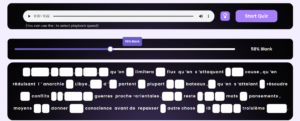La bise, a foreign concept for some (me).
I’ve been in France for a few short months, and “la bise” is still quite novel to me. My opportunities to “faire la bise” are limited, but my wife experiences it regularly through her friends at our kids’ school. For both of us, this French greeting has a bit of a learning curve.
We’re diving in with both feet… or I should say, both cheeks. To get acquainted with “faire la bise,” dive into Balades Episode 1. While it’s not the same as the actual mid-air peck by the cheek common throughout France, this episode provides some valuable insights.
This aspect of French culture is as natural to the French as horizontal stripes on clothing and “la goûter.” However, for a foreigner like me, there are many unknowns. This episode of Balades paints a detailed, if perhaps overwhelming, picture of this tradition.

Why learn with Balades?
I love Balades for learning French for a number of reasons. She has short, snappy episodes with a couple topics in each. This is great for quick learning. She is a French teacher and speaks quite clearly. It has transcripts available. All these make it great for learners at an A1 to B1 level. The pace is slower, but it’s not boring for learning. What do you think of Balades?
Now, let’s dive into some culture…

The Art of “La Bise” in France
Faites le compte : vous arrivez ainsi très vite à 100, 150, 200 bises et même plus… A propos de bises : En France, faire la bise est tout un art. C’est en tout cas ce que certains visiteurs étrangers peuvent penser.
In France, “faire la bise” or “la bise” is a common greeting practice involving cheek kisses. It’s more than a greeting; it’s a cultural norm deeply embedded in French social interactions. And that, I believe is what makes this practice a bit intriguing and confusing.
What is “La Bise”?
“La bise” refers to the act of kissing someone on the cheeks as a greeting. The number of kisses varies by region, typically ranging from one to four. It’s common among friends, family, and even colleagues.
I love the passage where the speaker says, “let’s do the math,” juxtaposing it with a foreigner’s view of it being an art. Perhaps I’m overthinking “la bise.” I should let it happen naturally and, like dancing, let the French lead. This perspective helps me breathe easier and worry less. It’s not about getting it right, or fretting getting it wrong, like dancing, let them lead and see where it goes.

Who, What, Where, Why, When?
En général, on se fait la bise en famille et entre amis. Les femmes entre elles se font la bise, ou bien une femme à un homme. Et mêmes deux hommes peuvent se faire la bise, si par exemple ils sont frères.
“La bise” involves understanding when and between whom this greeting is appropriate. Here’s a closer look at these social nuances:
Family and Friends
In general, “la bise” is most commonly exchanged within family and friend circles. This gesture signifies warmth, affection, and a sense of familiarity. It is a way to strengthen social bonds and convey a personal connection.
Women
Women in France often exchange “la bise” with each other, whether they are friends, family members, or acquaintances. This practice is a standard part of female social interactions and is expected in most social settings.
Women and Men
It is also common for a woman to exchange “la bise” with a man. This occurs frequently among friends, family, and colleagues who have a friendly relationship. The gesture is seen as a polite and friendly way to greet one another.
Men
While it is less common for men to exchange “la bise” with each other compared to women, it does happen, especially among close male relatives like brothers. In some regions and social circles, male friends might also greet each other with “la bise,” reflecting a strong bond or long-standing friendship.
Social Context
Understanding the appropriate context for “la bise” is crucial:
- Formal vs. Informal: In more formal settings or with people you don’t know well, a handshake might be more appropriate than “la bise.”
- Generational Differences: Younger generations may be more likely to engage in “la bise” with friends of the same gender, while older generations might reserve it for family or close friends.
Cultural Acceptance
The acceptance and expectation of “la bise” can vary:
- Urban vs. Rural: In urban areas, people might be more accustomed to a diverse set of greeting practices, while rural areas might adhere more strictly to traditional customs.
- International Influence: As France becomes more culturally diverse, there is greater flexibility and understanding regarding different greeting practices.

Everywhere a bit different
Ensuite une autre difficulté est que le nombre de bises varie selon la région et même le département. Cela peut aller d’une seule bise, comme par exemple dans le Finistère à l’ouest de la Bretagne, jusqu’à quatre bises dans les départements qui entourent l’Île-de-France, c’est-à-dire Paris et les départements autour de Paris.
En plus, il y a ceux qui commencent par la joue droite et d’autres par la joue gauche.Dans ma famille, on se fait trois à quatre bises et en général, nous commençons par la joue droite.
The number of kisses in “la bise” can differ greatly across France, adding another layer of complexity to this cultural practice. Understanding these regional variations is crucial for navigating social interactions smoothly.
Number of Kisses by Region
The number of kisses, or “bises,” you give when greeting someone varies not just by region but sometimes even by department. Here are some notable differences:
- Paris and Surrounding Areas (Île-de-France): Generally, people in these areas give four kisses. This includes Paris and its surrounding departments.
- Northern France: Typically, two kisses are exchanged.
- Southern France: It’s common to see three kisses, but in some areas, people might give four.
- Western France (Finistère, Brittany): In certain parts like Finistère, people often give just one kiss.
- Other Regions: The practice can vary widely, with two kisses being a standard in many places but subject to local customs.
Starting Side: Right or Left?
Another complexity is which cheek to start with. This too can vary:
- Right Cheek First: Many families and regions prefer starting with the right cheek. For example, in the speaker’s family, they start with the right cheek and give three to four kisses.
- Left Cheek First: In some areas, people might start with the left cheek.
Social and Familial Practices
In addition to regional differences, family traditions can influence how many kisses are exchanged. For instance, in the speaker’s family, it’s customary to give three to four kisses, starting with the right cheek. These familial customs can sometimes override regional norms.

Just kidding, well not really
Vous allez me dire que cela est tout à fait normal. Bien sûr, vous avez raison, mais quand on travaille dans une grande entreprise avec beaucoup d’employés, cela prend presque toute la matinée. Bon d’accord, j’exagère un peu. Mais en tout cas, cela prend un certain temps.
In the clip, she is using a bit of humor to exaggerate the time it takes to perform “la bise” in a large workplace, but there is a kernel of truth to it. I’m not an expert in French businesses or ongoings, but I do know my banker has said to me “ this is a top priority, extremely important and I know how serious this is for your side. I will get on it immediately. But first I will take my lunch”.
To me, it seems there’s a different priority level that exists in a French business vs an American business. Often in an American business the stakes are high: there’s something on the line, someone’s job, someone’s future, someone’s life!. In a French business, it seems thos stakes are different, it’s just business. So, if I get back to the email a bit later because I was busy greeting colleagues after an extended vacation, sobeit.
Reality of “La Bise” in the Workplace
Social Routine
Daily Routine: In many French workplaces, it is customary to greet colleagues individually, which can include exchanging “la bise.” This is a social ritual that helps build camaraderie and a sense of community.
Time Management: While it may take a few minutes to greet each colleague, most people manage this within a reasonable amount of time. In large offices, people might not greet every single person every day, focusing instead on those they interact with more regularly.
Practical Considerations
Adaptation in Large Workplaces: In very large companies, practicalities often dictate that not everyone will exchange “la bise” with every colleague daily. Instead, people might greet those in their immediate vicinity or team.
Efficiency: Employees and managers are generally aware of the need to balance social niceties with work efficiency. Thus, while “la bise” is respected, it is not allowed to significantly disrupt the workday.
Cultural Importance
Maintaining Relationships: “La bise” plays an important role in maintaining personal relationships and a pleasant work environment. It’s a way to show respect and friendliness.
Integration of Newcomers: New employees often observe and gradually adapt to the office’s specific customs regarding “la bise,” understanding that it’s part of the social fabric.

Embrace the French Way
“La bise” is more than a greeting; it’s a cultural experience that can enrich your understanding of French society. By listening to Balades Episode 1, you gain valuable insights and appreciate the nuances of this practice.
So, let’s embrace these cultural practices, learn from them, and enjoy the journey of mastering French with each podcast episode. Dive into the rich cultural insights offered by Balades and let each lesson bring you closer to the heart of France.









What an excellent post! It is a delight to read your insightful analysis presented in an interesting way. This article taught me a lot, and I will be using it again and again. Your expertise is much appreciated.